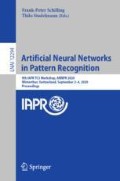Abstract
Deep excavations are today mainly designed by manually optimising the wall’s geometry, stiffness and strut or anchor layout. In order to better automate this process for sustained excavations, we are exploring the possibility of approximating key values using a machine learning (ML) model instead of calculating them with time-consuming numerical simulations. After demonstrating in our previous work that this approach works for simple use cases, we show in this paper that this method can be enhanced to adapt to complex real-world supported excavations. We have improved our ML model compared to our previous work by using a convolutional neural network (CNN) model, coding the excavation configuration as a set of layers of fixed height containing the soil parameters as well as the geometry of the walls and struts. The system is trained and evaluated on a set of synthetically generated situations using numerical simulation software. To validate this approach, we also compare our results to a set of 15 real-world situations in a t-SNE. Using our improved CNN model we could show that applying machine learning to predict the output of numerical simulation in the domain of geotechnical engineering not only works in simple cases but also in more complex, real-world situations.
Access this chapter
Tax calculation will be finalised at checkout
Purchases are for personal use only
References
Zswalls™, a 2D deep excavation - retaining wall analysis software program (2018). https://www.zsoil.com/zswalls/
Zsoil, elmepress (2019). http://www.zsoil.com
Commend, S., Geiser, F., Crisinel, J.: Numerical simulation of earthworks and retaining system for a large excavation. Adv. Eng. Softw. 35, 669–678 (2002). https://doi.org/10.1016/j.advengsoft.2003.10.011
Commend, S., Wattel, S., Hennebert, J., Kuonen, P., Vulliet, L.: Prediction of unsupported excavations behaviour with machine learning techniques. In: Proceedings of XIV International Conference on Computational Plasticity, Fundamentals and Applications, COMPLAS 2019, 3–5 September 2019, Barcelona, Spain (CONFERENCE), 7 p. (2019). http://hesso.tind.io/record/4094
Goncharova, Y.A., Indrupskiy, I.M.: Replacement of numerical simulations with machine learning in the inverse problem of two-phase flow in porous medium. J. Phys. Conf. Ser. 1391, 012146 (2019). https://doi.org/10.1088/1742-6596/1391/1/012146
van der Maaten, L., Hinton, G.: Visualizing data using t-SNE. J. Mach. Learn. Res. 9, 2579–2605 (2008)
Moiz, A., Pal, P., Probst, D., Pei, Y., Zhang, Y., Som, S., Kodavasal, J.: A machine learning-genetic algorithm (ML-GA) approach for rapid optimization using high-performance computing. SAE Int. J. Commercial Veh. (2018). https://doi.org/10.4271/2018-01-0190
Obrzud, R., Preisig, M.: Large scale 3D numerical simulations of deep excavations in urban areas-constitutive aspects and optimization. Mitt. der Geotechnik Schweiz 167, 57–68 (2013)
Paternina-Arboleda, C., Montoya-Torres, J., Fabregas, A.: Simulation-optimization using a reinforcement learning approach, pp. 1376–1383 (2008). https://doi.org/10.1109/WSC.2008.4736213
Settles, B.: Active learning literature survey. Computer Sciences Technical report 1648, University of Wisconsin-Madison (2009)
Tompson, J., Schlachter, K., Sprechmann, P., Perlin, K.: Accelerating Eulerian fluid simulation with convolutional networks. In: Precup, D., Teh, Y.W. (eds.) Proceedings of the 34th International Conference on Machine Learning. Proceedings of Machine Learning Research, vol. 70, pp. 3424–3433. PMLR, International Convention Centre, Sydney, Australia (2017). http://proceedings.mlr.press/v70/tompson17a.html
Acknowledgment
This publication is written in the framework of the Optisoil project co-funded by the swiss Hasler Foundation.
Author information
Authors and Affiliations
Corresponding author
Editor information
Editors and Affiliations
Rights and permissions
Copyright information
© 2020 Springer Nature Switzerland AG
About this paper
Cite this paper
Wolf, B. et al. (2020). Using CNNs to Optimize Numerical Simulations in Geotechnical Engineering. In: Schilling, FP., Stadelmann, T. (eds) Artificial Neural Networks in Pattern Recognition. ANNPR 2020. Lecture Notes in Computer Science(), vol 12294. Springer, Cham. https://doi.org/10.1007/978-3-030-58309-5_20
Download citation
DOI: https://doi.org/10.1007/978-3-030-58309-5_20
Published:
Publisher Name: Springer, Cham
Print ISBN: 978-3-030-58308-8
Online ISBN: 978-3-030-58309-5
eBook Packages: Computer ScienceComputer Science (R0)


